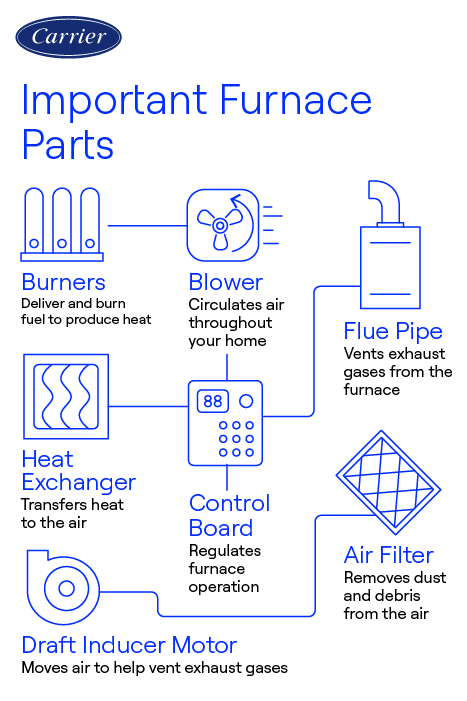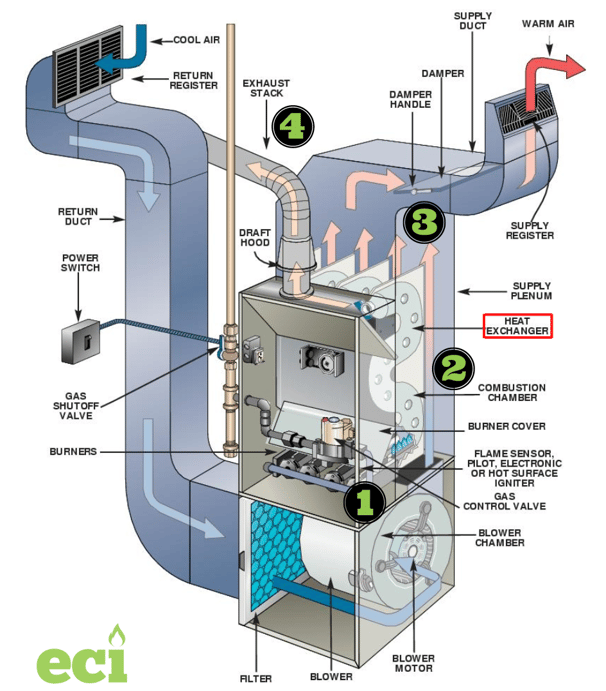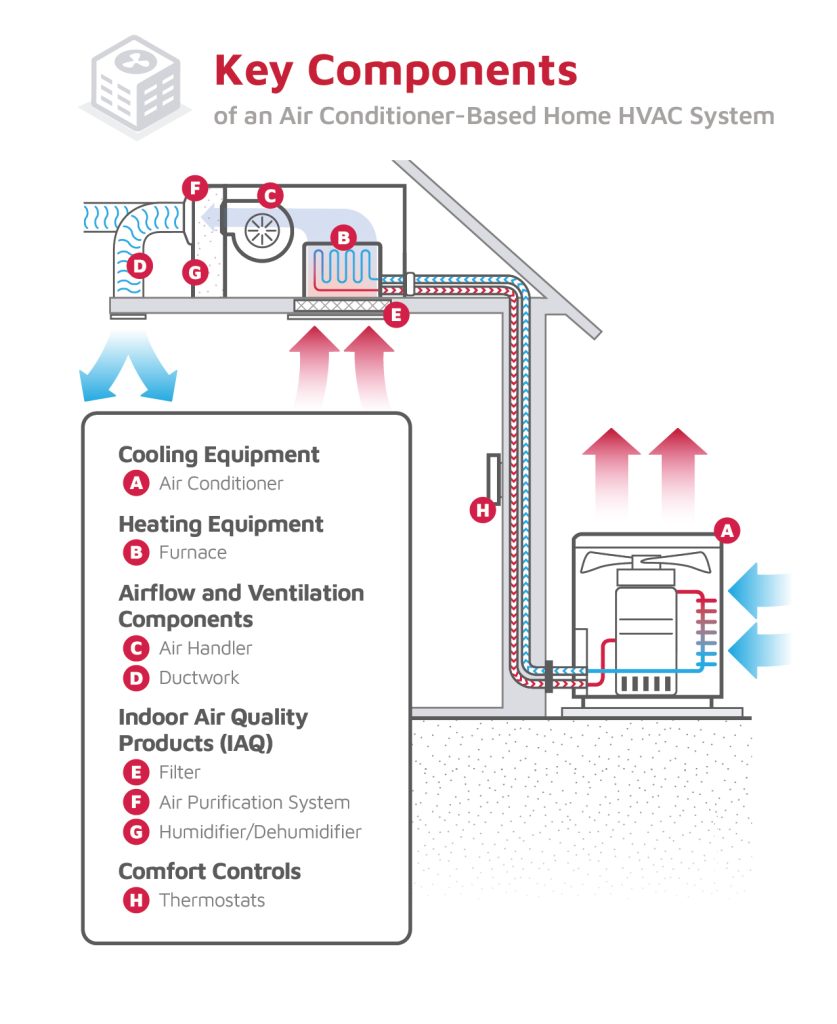Have you ever wondered if your furnace is actually part of your HVAC system? Understanding this can help you take better care of your home’s heating and cooling.
Knowing how your furnace fits into the bigger picture of HVAC can save you money, improve comfort, and prevent costly repairs. Keep reading to discover the connection between your furnace and HVAC, and learn what you need to know to keep your home cozy all year round.

Credit: www.carrier.com
Furnace Basics
The furnace is a key part of many heating systems inside homes. It works quietly to keep rooms warm during cold months. Understanding the furnace basics helps clarify its role in HVAC systems. This section covers what a furnace does and the different types available.
What A Furnace Does
A furnace heats air and sends it through ducts to warm the whole house. It uses fuel sources like gas, electricity, or oil. The furnace turns on when the thermostat senses a drop in temperature. Inside, the furnace heats air with a burner or electric elements. Then, a blower pushes warm air into rooms. This process helps maintain a comfortable indoor temperature.
Types Of Furnaces
Furnaces come in several types based on how they generate heat and what fuel they use. Common types include:
- Gas Furnaces:Use natural gas to create heat. Popular for their efficiency and cost.
- Electric Furnaces:Use electric coils to warm air. Easy to install but may cost more to run.
- Oil Furnaces:Burn oil to produce heat. Often found in areas without natural gas access.
- Propane Furnaces:Use propane gas. Common in rural locations.
Each type fits different home needs and budgets. Choosing the right one depends on fuel availability and efficiency preferences.
Hvac System Components
The HVAC system in your home does more than just control the temperature. It works through several key components that handle heating, cooling, and ventilation. Understanding these parts helps you see where your furnace fits and how it keeps your indoor environment comfortable all year round.
Heating Elements
The furnace is a major heating element of the HVAC system. It generates warmth by burning fuel or using electricity to heat air, which is then distributed through your home. Other heating elements might include heat pumps or boilers, but the furnace is often the heart of home heating.
Have you ever noticed how your furnace kicks on before the room feels warm? That delay happens because it’s warming the air before sending it out. Knowing this can help you spot when your furnace is not working efficiently.
Cooling Elements
Cooling is handled by different parts like air conditioners or heat pumps in the HVAC system. These components remove heat from your home and blow cool air inside. They work in opposition to the furnace but are just as important for comfort during hot months.
Think about how your AC unit feels when it’s running smoothly versus when it struggles. Proper maintenance of cooling elements ensures they work efficiently, just like your furnace.
Ventilation Role
Ventilation moves fresh air into your home and pushes stale air out. Ductwork, vents, and fans make this happen, keeping air quality high and balancing temperature. Without proper ventilation, neither your furnace nor your AC can keep your home comfortable or healthy.
Ever wondered why some rooms feel stuffy even with the heater or AC running? It often points to ventilation issues. Checking your vents and ductwork can solve this problem quickly.
How Furnace Fits In Hvac
The furnace is a key part of many HVAC systems. It provides warmth during cold months. Understanding its role helps explain how HVAC keeps homes comfortable year-round. The furnace works with other parts to heat air and move it through your home.
Heating Within Hvac
The furnace creates heat by burning fuel or using electricity. This heat warms the air inside the system. Then, the warm air moves through ducts to rooms. It raises the temperature inside the house. The furnace is the main source of heat in many HVAC setups.
Integration With Other Parts
The furnace does not work alone. It connects with the air conditioner, thermostat, and ventilation. The thermostat controls when the furnace turns on or off. Ventilation helps move fresh air and keep air quality good. Together, these parts keep your home warm, cool, and fresh.
Furnace Vs Other Heating Options
When choosing a heating system for your home, it’s important to understand how a furnace stacks up against other options. Each heating method has unique features that might fit your needs differently depending on factors like energy source, efficiency, and climate. Let’s compare furnaces to some common alternatives to help you decide what works best for your space.
Heat Pumps
Heat pumps provide both heating and cooling by transferring heat rather than generating it. Unlike furnaces that burn fuel to create heat, heat pumps use electricity to move heat from outside to inside your home.
They are highly efficient in moderate climates but might struggle in extreme cold. If you live in an area with mild winters, a heat pump could lower your energy bills significantly.
Have you considered how often you’d want your system to cool as well as heat? Heat pumps offer that dual function without needing separate units.
Boilers
Boilers heat water to provide warmth through radiators or underfloor heating. This method offers a steady, comfortable heat that some find more soothing than forced air from furnaces.
They use natural gas, oil, or electricity, but generally require more maintenance than furnaces. Boilers excel in older homes or those with existing radiator systems.
Ask yourself if you prefer the quiet, even heat of a boiler or the quick, strong blasts from a furnace’s vents.
Electric Heaters
Electric heaters convert electricity directly into heat using coils or infrared technology. They are easy to install and ideal for smaller spaces or supplemental heating.
However, they tend to have higher operating costs compared to furnaces or heat pumps, especially in larger homes. Electric heaters don’t rely on fuel combustion, making them cleaner but sometimes less cost-effective.
Consider whether you need a full-house solution or just occasional extra warmth in specific rooms.
Benefits Of A Furnace In Hvac
A furnace plays a key role in many HVAC systems. It provides warmth by heating air and distributing it through your home. This makes living spaces comfortable during cold seasons. Furnaces offer several important benefits that improve your home’s heating experience and energy use.
Efficiency
Furnaces convert fuel into heat with high efficiency. Modern models use less energy to warm your home. This means you get more heat for every unit of fuel. Efficient furnaces reduce waste and lower your energy bills.
Cost-effectiveness
Furnaces have lower installation costs compared to some heating systems. They also require less maintenance over time. This keeps your overall expenses down. Many furnaces last for 15 to 20 years, providing good value.
Reliability
Furnaces work well in cold climates and last long. They provide steady heat without sudden drops in temperature. Regular servicing keeps them running smoothly and safely. This makes furnaces a dependable choice for home heating.

Credit: www.ecicomfort.com
Maintenance Tips For Furnaces
Furnaces are a key part of HVAC systems, providing heat during cold months. Regular maintenance keeps them working safely and efficiently. Simple tasks like changing filters and cleaning vents improve furnace performance and air quality.
Maintaining your furnace is crucial for efficient HVAC performance. Regular care ensures your system runs smoothly, prolonging its life and keeping your home comfortable. Here are some practical maintenance tips for furnaces.Regular Inspections
Inspect your furnace regularly to catch issues early. Look for visible signs of wear or damage. Check for unusual noises or smells. Early detection helps prevent costly repairs.Filter Replacement
Replace furnace filters every 1-3 months. Clean filters improve air quality and system efficiency. Clogged filters can strain your system, leading to breakdowns.Professional Servicing
Schedule professional servicing annually. Experts can spot hidden problems and perform necessary repairs. Regular servicing ensures optimal furnace performance and safety.Common Furnace Problems
Furnaces are essential components of many HVAC systems, but they can encounter several common problems that affect their performance. Understanding these issues can save you time and costly repairs. Let’s look at some frequent furnace problems you might face and how to spot them early.
Ignition Issues
One of the most frustrating furnace problems is ignition failure. If your furnace doesn’t light up or keeps shutting off unexpectedly, the ignition system might be the culprit. This could be due to a dirty pilot light, faulty ignitor, or problems with the gas supply.
Have you noticed a delay in the furnace starting or strange clicking sounds? These are often signs that your ignition system needs inspection. Fixing ignition issues quickly prevents your home from getting cold and reduces the risk of gas leaks.
Airflow Problems
Poor airflow is another common furnace issue that affects comfort and efficiency. Dust-clogged filters, blocked vents, or malfunctioning blowers can restrict airflow, making your furnace work harder than necessary.
When the airflow is weak, some rooms may feel colder while others are warmer. You might also hear unusual noises or notice increased energy bills. Regularly cleaning or replacing filters and ensuring vents are open can improve airflow significantly.
Thermostat Malfunctions
Your thermostat controls the furnace, so when it malfunctions, the whole system suffers. Erratic temperature readings or a furnace that won’t turn on can often be traced back to thermostat problems.
Sometimes, the issue is as simple as dead batteries or incorrect settings. Other times, the thermostat may need recalibration or replacement. Have you checked your thermostat’s settings recently? Making sure it’s working correctly keeps your home comfortable and your furnace running smoothly.

Credit: www.searshomeservices.com
Choosing The Right Furnace
A furnace is a key part of an HVAC system, responsible for heating indoor air. Choosing the right furnace ensures comfort and energy efficiency in your home. It works with other HVAC components to maintain a balanced temperature year-round.
Choosing the right furnace is crucial for your HVAC system. It impacts comfort, efficiency, and cost. With various options, making the best choice can be challenging. Below, explore key factors in selecting the ideal furnace.Sizing Considerations
Proper sizing is vital for furnace efficiency. A furnace that’s too large wastes energy. A small one struggles to heat your home. Calculate the correct size using square footage and climate zone. Consult a professional for accurate sizing.Fuel Types
Furnaces use different fuel types. Common options include natural gas, oil, and electricity. Natural gas is efficient and widely available. Oil is less common but offers high heat output. Electric furnaces are easy to install and maintain. Choose based on availability and cost-effectiveness.Energy Ratings
Energy ratings indicate furnace efficiency. Look for AFUE ratings. A higher AFUE means better efficiency. Consider furnaces with Energy Star certification. They meet strict efficiency guidelines. An efficient furnace reduces energy bills and environmental impact.Frequently Asked Questions
Is A Furnace Included In Hvac Systems?
Yes, a furnace is a key part of HVAC systems. It provides heating by warming air and distributing it through ducts. HVAC stands for heating, ventilation, and air conditioning, so the furnace handles the heating component efficiently.
How Does A Furnace Work In Hvac?
A furnace heats air using fuel or electricity. It pushes warm air through ducts to heat your home. The HVAC system controls the furnace to maintain a comfortable temperature automatically.
Can Hvac Systems Function Without A Furnace?
Yes, HVAC systems can work without a furnace. Some use heat pumps or electric heaters instead. However, furnaces are common in colder climates for effective, reliable heating.
What Types Of Furnaces Are In Hvac Systems?
Common furnace types include gas, electric, and oil furnaces. Each uses different energy sources but serves the same HVAC heating purpose. Choosing depends on energy availability and efficiency preferences.
Conclusion
A furnace is definitely part of an HVAC system. It helps heat your home during cold months. HVAC also includes cooling and ventilation parts. Understanding this helps you care for your system better. Regular maintenance keeps everything running smoothly. Knowing your furnace role saves energy and money.
A well-working HVAC system improves comfort inside your house. Now, you can see how important the furnace really is. Simple steps can extend its life and efficiency. Keep your home warm and cozy with proper care.





